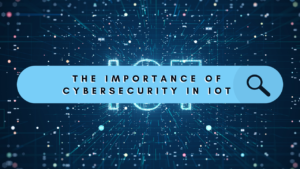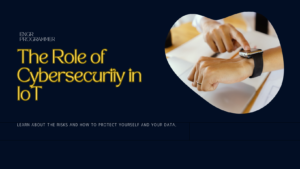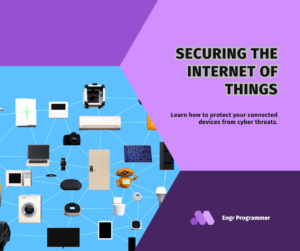Introduction
In today’s digitally connected world, where appliances and devices can connect and exchange data with ease, the Internet of Things (IoT) is a fundamental part of our daily lives. But as the variety of linked devices increases, so do the potential risks and vulnerabilities brought on by the IoT. As risks to Internet of Things (IoT) systems and losses of sensitive data increase in frequency, cybersecurity is becoming more crucial. This blog discusses the value of cybersecurity in the Internet of Things (IoT) and offers information on best practices and security tools that can help safeguard our networked society.
Knowing the Internet of Things (IoT)
The network of physical technological developments, such as automobiles, appliances, and other items equipped with software, sensors, and connections to enable data sharing and communication, is known as the Internet of Things (IoT). Because of our interconnection, we can automate processes and efficiently govern many elements of our lives. It also presents fresh security difficulties, though.

It is essential to realize how these linked devices work to fully appreciate the value of cybersecurity in the IoT. Understanding the complexity of IoT systems will help us better understand possible vulnerabilities and put in place efficient security solutions.
The risks of a connected world
As the Internet of Things (IoT) keeps expanding into our daily lives, we need to be aware of the vulnerabilities and risks associated with this interconnection. If sufficient cybersecurity protections are not in place, the comfort and precision that IoT delivers can be quickly compromised.
Unauthorized access to confidential information is one of the main dangers of a connected world. With IoT devices gathering and exchanging data, hackers may take advantage of flaws in the system to access personal information without authorization or even remotely manage connected equipment. Negative effects including privacy violations, money losses, and in some cases even physical harm, can result from this.
Additionally, scammers have a wider attack surface due to the sheer number of linked devices. As a potential network entry point, every device makes it more difficult to fully safeguard each endpoint. Because of this intricacy, there is an increased requirement for strong security measures to defend against potential dangers.
Establishing a robust cybersecurity strategy for IoT devices is essential to addressing these issues. This entails performing frequent software and firmware updates, putting in place reliable authentication measures, and encrypting the transmission of data. To ensure that people are aware of possible dangers and can take the necessary safeguards, educating users about dangers and recommended practices for Internet of Things security is also essential.
The role of cybersecurity in the IoT
The protection of Internet of Things devices and the information that they gather depends heavily on cybersecurity. It entails putting several plans, tools, and techniques into action to reduce risks and safeguard the network of connected devices.
Authorization and access control are two essential components of cybersecurity in the Internet of Things. Robust authentication processes guarantee that only authorized parties can access and use IoT devices. Secure usernames and passwords multi-factor authorization, and biometric verification can all help achieve this.

Data encryption is another essential component. An additional line of defense against unwanted access is provided by encrypting data during transmission and storage. It guarantees that data will remain unreadable to anyone lacking the encryption key, even if it is intercepted.
For IoT security, regular firmware and software updates are also essential. These updates frequently include fixes for well-known vulnerabilities, strengthening the devices’ overall resistance. Installing these updates as soon as possible is crucial to avoiding future hacker abuse.
Moreover, by separating IoT devices from different network segments, network segmentation can improve security. A security compromise can have less of an impact if devices are grouped according to their functionality and stringent access controls are put in place between segments.
Best practices for securing IoT devices

Firstly, on Internet of Things devices, changing the default password is crucial. Manufacturers frequently employ default passwords that are simple for hackers to figure out. You may significantly reduce the chance of unwanted access by making solid one-of-a-kind passwords for every device.
Secondly, it is essential that you update your IoT devices’ firmware and software on a regular basis. Updates addressing security flaws are regularly released by manufacturers. You can make sure you have the most recent defense against potential dangers by keeping your gadgets up to date.
Next, on your IoT devices, think about turning off unused features and services. A device’s potential vulnerabilities increase with its feature count. Removing unnecessary services lowers the potential for attack and lessens the likelihood that your devices will be hacked.
Furthermore, keeping your home or office network secure is essential. Enable network encryption and choose a solid, one-of-a-kind password for your Wi-Fi network. Make sure that a firewall is installed and operational to track and filter both inbound and outbound traffic.
Lastly, for your IoT devices, think about utilizing a dedicated network. An additional layer of security is created by keeping your IoT devices apart from your main network. The dedicated network alone would be affected if a device were compromised, not your whole network infrastructure.
By following these best practices, you can significantly improve the security of your IoT devices.
The importance of collaboration and information sharing
It is imperative that researchers, manufacturers, and cybersecurity experts work together. Manufacturers ought to encourage responsible danger reporting and have active conversations with security researchers. Collaboratively, dangers can be found and fixed before they become exploitable, making IoT devices more secure right from the start.
In addition, exchanging threat information and best practices is essential to fighting the constantly changing threat landscape. Stakeholder collaboration and information sharing should be encouraged by government agencies, trade associations, and cybersecurity organizations. The whole Internet of Things ecosystem can gain from and fortify its defenses against cyberattacks by exchanging information and experiences.
End users can also be included in sharing information and collaborating efforts. Users ought to be proactive in putting security measures in place and keep up to date on the most recent cybersecurity threats. By exchanging insights and best practices with other users, you can build a community of watchful people who are all working together to safeguard their interconnected world.
The future of cybersecurity in the IoT
The security threats connected with the Internet of Things (IoT) are growing as well. Technology breakthroughs and shifting threat dynamics will influence cybersecurity in the Internet of Things in the future. Keeping up with these advancements is crucial to maintaining the security of our globalized society.

One thing to think about is how devices are becoming more and more connected. As more gadgets join the Internet of Things, the area that could be attacked grows. This means that when designing and developing IoT devices, strong security measures must be put in place. To stop vulnerabilities from being exploited, manufacturers need to prioritize security and maintain a constant state of alertness.
The utilization of machine learning (ML) and artificial intelligence (AI) is a key component of cybersecurity. Threat detection and reaction in the Internet of Things could be completely transformed by these technologies. AI and ML can assist in the real-time identification and reduction of cyber threats by sifting through enormous quantities of data and looking for patterns.
In addition, privacy protection will receive more attention in the coming years of cybersecurity in the Internet of Things. Strong privacy protocols are essential since IoT devices are gathering and sharing a growing amount of sensitive data. Standards and regulations set by the industry will be crucial in ensuring that personal data is handled responsibly.
Conclusion
To address evolving threats, manufacturers, researchers, and experts must work together to ensure cybersecurity in the Internet of Things. Progress in technology, threat detection with AI and ML, and strong privacy controls are essential for the future. Ensuring device security during development and adhering to regulations and standards are crucial. A secure IoT ecosystem requires ongoing awareness-raising and education about new technologies and cyber threats. IoT benefits are ensured while everyone’s security and privacy are protected through adherence to responsible practices.
The article you may also like:)